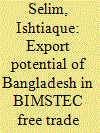|
|
|
Sort Order |
|
|
|
Items / Page
|
|
|
|
|
|
|
| Srl | Item |
| 1 |
ID:
136587


|
|
|
|
|
| Summary/Abstract |
India is emerging as a global economic power and expanding its military capabilities. Its maritime posture in the Indo-Pacific has made it an important stakeholder in the Asia-Pacific strategic ambiguity. The country is invited in almost all global forums and encouraged to play active role in the international affairs. These are some of the key indicators of India’s global emergence. By contrast, India is yet to take strong footholds in several global issues, while negotiating with international powers e.g. the USA and China. Some major challenges of the global emergence of India are its foreign policy predicaments, neighbourhood compulsions and China bogey, compulsions of energy import, limits of its soft power capabilities, internal security threats and domestic underdevelopment. In this context, the two important research questions of this paper are: which factors indicate India as an emerging global power? And, what are the challenges for India’s global emergence? The paper concludes that due to emerging economic and military power, India’s role in the international arena are increasing, but the country faces both internal and external challenges to project itself as a global power.
|
|
|
|
|
|
|
|
|
|
|
|
|
|
|
|
| 2 |
ID:
136590


|
|
|
|
|
| Summary/Abstract |
Climate change is a serious and inevitable threat for Bangladesh. The country faces significant challenges to its overall development due to frequent flooding, tropical cyclones, droughts and other natural calamities, all of which deplete a significant amount of the annual national budget. Researches show that climate change has increased the frequency of the natural disasters and is likely to intensify further in the future. It is estimated that, climate change combined with the threat of sea level rise, would cause forced-displacement of millions of people from low-lying and coastal areas of densely populated Bangladesh. The paper reveals that climate change has severe impacts on Bangladesh due to its unique geographical location and socio-economic characteristics. This suggests that climate change poses security threats for Bangladesh in terms of weakening the elements of national power and generating violence in the society. The paper also explored that though Bangladesh is making all out efforts to face climate change, but for obvious reason the role of armed forces has not yet been emphasised at the national strategic level. As such, this paper suggests for the incorporation of Bangladesh armed forces in the national response plans on climate change issues.
|
|
|
|
|
|
|
|
|
|
|
|
|
|
|
|
| 3 |
ID:
136586


|
|
|
|
|
| Summary/Abstract |
Bangladesh has been striving hard to exploit SAFTA for boosting its TRADEand economic relations with the South Asian neighbours. But this free trade agreement is yet to bring sufficient dividends for Bangladesh. While the role of regional integration in the development process is undeniable, the slow progress of SAFTA in South Asia is a source of frustration for a developing nation like Bangladesh. Accordingly, in an effort to yield trade and economic gains, Bangladesh has become a member of BIMSTEC-FTA. This article uses augmented gravity equation to estimate Bangladesh’s export potentials in BIMSTEC-FTA. It estimates an export equation for Bangladesh taking some relevant variables into account. Also, the model undergoes some diagnostic tests. On the basis of the tests the model is cleared of multicollinearity and heteroscedasticity problems. The results from the estimations show that Bangladesh has export potentials in BIMSTEC-FTA. Therefore, the country’s economy might take advantages from boosting exports to developing economies of BIMSTEC, namely, India and Thailand.
|
|
|
|
|
|
|
|
|
|
|
|
|
|
|
|
| 4 |
ID:
136588


|
|
|
|
|
| Summary/Abstract |
The recent settlement of long-standing maritime boundary dispute with India and Myanmar ushers a new horizon for economic development for Bangladesh through utilising the sea and its marine resources. The judgment, not to mention, bears huge implications in many dimensions. Both the verdicts have removed all encumbrances to go ahead with oil and gas exploration in the blocks therein. This will enable Bangladesh to establish ‘Blue Economy’, an alternative economic model, utilising all its marine resources. The concept of ‘Blue Economy’, can significantly contribute to the economic development of Bangladesh. There is no doubt that sea-related issues like expansion of international TRADE, use of marine mineral resources for long-term energy security, proper management of marine fish resources and protection of marine environment and bio-diversity would determine Bangladesh’s future development and economic growth. Bangladesh can be benefited only when it can explore and utilise those resources from the sea. Given this backdrop, this paper attempts to discuss maritime dispute and verdict of Bangladesh in a nutshell, analyse the Bay of Bengal as a hub of huge exploration, challenges therein and finally put forward suggestions for exploring enormous opportunities in the newly settled maritime area.
|
|
|
|
|
|
|
|
|
|
|
|
|
|
|
|
| 5 |
ID:
136589


|
|
|
|
|
| Summary/Abstract |
Contemporary security scenario in Afghanistan appears remote from achieving peace, security and stability in a country that has had been experiencing decades-long armed conflict, insurgency, extremism, terrorism and violence of all kinds. Lately, incidences of armed conflicts, insurgent and terrorist activities are on the rise leading to increased casualties and deaths of the civilians. Principal factors responsible for undermining security and stability in Afghanistan include, but not limited to the continuing insurgency by the Taliban fighters and the terrorism perpetrated by various militant armed groups based both in Afghanistan and across the border. The United States-led International Security Assistance Force, a multinational stabilisation force, on the other hand, is responsible to provide security and stability in Afghanistan since its deployment in 2001. After thirteen years of prolonged counter insurgency and counter terrorism efforts of the ISAF, Taliban insurgency is still showing remarkable strength and little sign of receding shortly making prospects for peace and security in Afghanistan very much obscure. After reviewing the recent security situation in Afghanistan, questions can be raised as to the roles of ISAF in Afghanistan and what are the impacts of their initiatives as insurgency and terrorism continue to bleed the country. The paper argues that lack of success on the part of ISAF in achieving its objectives in Afghanistan is explicitly evident given the rising state of insecurity and instability in recent times. The paper, however, also discusses the various challenges confronted by ISAF in continuing its operations in Afghanistan. At the end, the analysis exhibits some ways forward in achieving peace and security in Afghanistan and establishing sustainable democratic governance in the country.
|
|
|
|
|
|
|
|
|
|
|
|
|
|
|
|
|
|
|
|
|